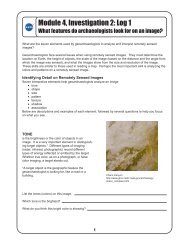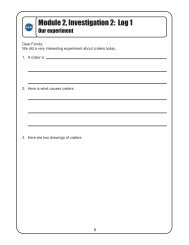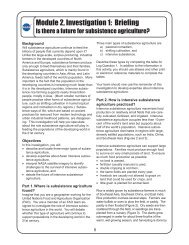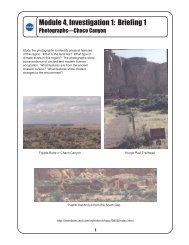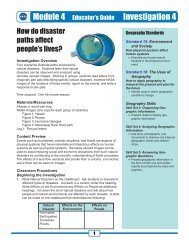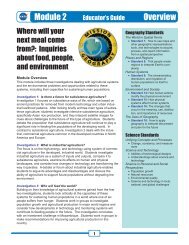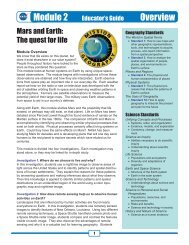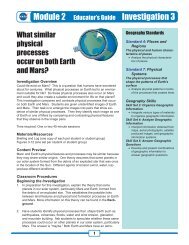What is there to see from sea to shining sea? - Mission Geography
What is there to see from sea to shining sea? - Mission Geography
What is there to see from sea to shining sea? - Mission Geography
You also want an ePaper? Increase the reach of your titles
YUMPU automatically turns print PDFs into web optimized ePapers that Google loves.
Module 3 Educa<strong>to</strong>r’s Guide Investigation 2<strong>What</strong> <strong>is</strong> <strong>there</strong> <strong>to</strong><strong>see</strong> <strong>from</strong> <strong>sea</strong> <strong>to</strong><strong>shining</strong> <strong>sea</strong>?Investigation OverviewTh<strong>is</strong> investigation builds on the first investigationin th<strong>is</strong> module. Students locate andidentify physical and human-made features in theUnited States using images <strong>from</strong> space and create their own U.S. mapsthat are illustrated with NASA images. The song “America the Beautiful” <strong>is</strong>used <strong>to</strong> help students recognize that our country has many differentregions and that the landscape of our country <strong>is</strong> very diverse.Time required: Two 45-minute sessionsMaterials/ResourcesAtlases or U.S. maps (one for each group of four)Log 1: How many physical and human-made features can you find? (onefor each group of four)Log 2: <strong>What</strong> features make our country a special place? (one for eachgroup of four)Log 3: <strong>What</strong> features make our country a special place? (answer page)(one for each group of four)Log 4: Sea <strong>to</strong> <strong>shining</strong> <strong>sea</strong>—Images (one for each student)Poster board (one for each group)Masking tapeWall mapContent PreviewPlaces on Earth are characterized by their physical and human properties.Their natural physical features include climate, landforms, soils, bodies ofwater, vegetation, and animal life. Their human character<strong>is</strong>tics includelanguage, religion, political systems, economic systems, population d<strong>is</strong>tribution,and the features people construct such as cities, airports, roads,bridges, and canals. Both natural environmental features and humanmadefeatures are v<strong>is</strong>ible <strong>from</strong> space.<strong>Geography</strong> StandardsStandard 1: The World inSpatial TermsHow <strong>to</strong> use maps and othergeographic representations,<strong>to</strong>ols, and technologies <strong>to</strong> acquire,process, and report information<strong>from</strong> a spatial perspective• Identify and describe the character<strong>is</strong>ticsand purposes ofgeographic representation, <strong>to</strong>ols,and technologies.Standard 4: Places andRegionsThe physical and humancharacter<strong>is</strong>tics of places• Use a variety of graphic materialsand data sources <strong>to</strong> describe thephysical and human character<strong>is</strong>ticsof a region.<strong>Geography</strong> SkillsSkill Set 2: Acquire GeographicInformation• Make and record observationsabout the physical and humancharacter<strong>is</strong>tics of places.Skill Set 4: Analyze GeographicInformation• Use texts, pho<strong>to</strong>graphs, anddocuments <strong>to</strong> observe and interpretgeographic trends and relationships.Classroom ProceduresBeginning the Investigation1. Divide students in<strong>to</strong> groups of four and give each group an atlas and acopy of Log 1. Review the definition of physical and human-madefeatures. (Physical features describe the natural features of the landsuch as landforms and water bodies, and human-made features arethe character<strong>is</strong>tics of a place or region that are made by people.) Tellthem <strong>to</strong> look carefully at the satellite image and ask if anyone canidentify the city. It <strong>is</strong> San Franc<strong>is</strong>co, California. Now tell students <strong>to</strong>locate San Franc<strong>is</strong>co on the wall map and describe its location. (On1
Module 3 Educa<strong>to</strong>r’s Guide Investigation 2the west coast, near the Pacific Ocean, on a bay,etc.) Have them l<strong>is</strong>t the kinds of physical andhuman-made features they can <strong>see</strong> in the satelliteimage. D<strong>is</strong>cuss and compare their l<strong>is</strong>ts.2. Have the students find a physical map of theUnited States in the atlas and help them <strong>to</strong> identifythe physical features they <strong>see</strong> on the map byname. (Various mountain ranges, major lakes andrivers, deserts, etc.) If the wall map shows thesefeatures, <strong>there</strong> <strong>is</strong> no need <strong>to</strong> use the atlases.Developing the Investigation3. Divide the class in<strong>to</strong> groups and give each groupan atlas and a copy of Logs 2 and 3. Tell thestudents <strong>to</strong> cut out the three boxes in Log 3 andmatch them <strong>to</strong> the three correct images in Log 2.Have the students look at the images and d<strong>is</strong>cussthe kinds of physical and human-made featuresthey can <strong>see</strong>. Ask them <strong>to</strong> determine whether thefeatures are mostly physical or mostly humanmadeand circle the answer. Then have them l<strong>is</strong>texamples of these features. When students havecompleted the activity, d<strong>is</strong>cuss their answers.4. Tell the students that about 100 years agoKatharine Lee Bates wrote a poem which later wasmade in<strong>to</strong> a song by Samuel A. Ward. Th<strong>is</strong> songdescribes the United States’ wide skies, richfarmlands, mountains, and more. Ask if anyone canname the song. Have the class sing “America theBeautiful.”America the BeautifulO beautiful for spacious skies,For amber waves of grain,For purple mountain majestiesAbove the fruited plain!America! America!God shed H<strong>is</strong> grace on theeAnd crowned thy good with brotherhoodFrom <strong>sea</strong> <strong>to</strong> <strong>shining</strong> <strong>sea</strong>!5. Use the wall map <strong>to</strong> d<strong>is</strong>cuss the song. Havestudents help identify the places in the UnitedStates that we associate with “amber waves ofgrain” (the Great Plains); “purple mountain majesties”(coastal ranges, Sierra Nevadas, Cascades,Rockies, Appalachians); “the fruited plain” (southeasterncoastal plain including Florida).Concluding the Investigation6. Have the students work in their groups <strong>to</strong> draw anoutline map of the United States on a largeposterboard using an overhead projec<strong>to</strong>r. Instructthem <strong>to</strong> cut out the images <strong>from</strong> Log 4. Have themwork in small groups <strong>to</strong> decide where each imagebelongs on their maps. They should check thelocations on the wall map or in an atlas. Haveeach group attach its images on the posterboardmap with tape. D<strong>is</strong>cuss the map as a class andcorrect any m<strong>is</strong>placed images.Th<strong>is</strong> activity can be extended by having studentsaffix magazine pictures and postcards <strong>to</strong> the map.7. Ask each group <strong>to</strong> collaborate and write a poemthat will describe the images on the map. Suggestthat they identify and describe the geographicfeatures they learned about, and that they includeinformation on ways we can protect our country’senvironment <strong>from</strong> “<strong>sea</strong> <strong>to</strong> <strong>shining</strong> <strong>sea</strong>.” D<strong>is</strong>play thepoems in the classroom.Evaluation*Log 1: How many physical and human-madefeatures can you find?Physical features: bay, ocean, strait, peninsula,<strong>is</strong>landHuman-made features: city, buildings, bridges,streets, parks, roads, airport*Log 3: <strong>What</strong> features make our country a specialplace?Grand Canyon—image #1Lanai, Hawaii—image #4Lake Michigan and Chicago, Illino<strong>is</strong>—image #6*Log 4: Sea <strong>to</strong> <strong>shining</strong> <strong>sea</strong>1. San Franc<strong>is</strong>co2. Mount Rainier3. Sonoran Desert4. Great Salt Lake—Salt Lake City5. Rocky Mountains6. Albuquerque, New Mexico7. New Orleans8. Great Lakes9. Cape Canaveral, Florida10. Chesapeake Bay11. New York City2
Module 3, Investigation 2: Log 1How many physical and human-made features can you find?NameDatePhysical FeaturesHuman-Made Features13
Module 3, Investigation 2: Log 2<strong>What</strong> features make our country a special place?Directions: Cut out the boxes on Log 3. Match them <strong>to</strong> the three correct images.124 2
Module 3, Investigation 2: Log 2<strong>What</strong> features make our country a special place?345 3
Module 3, Investigation 2: Log 2<strong>What</strong> features make our country a special place?566 4
Module 3, Investigation 2: Log 3<strong>What</strong> features make our country a special place?NameDateDirections1. After you have matched the satellite images, look at each image <strong>to</strong> <strong>see</strong> if it has “mostly physical” or“mostly human-made” features. Circle your answer.2. Identify the kinds of physical and human-made features you can <strong>see</strong>.Grand Canyon, Arizona1) Mostly Physical Mostly Human-Made2) Identify the features you <strong>see</strong>:PhysicalHuman-MadeLanai Island, Hawaii1) Mostly Physical Mostly Human-Made2) Identify the features you <strong>see</strong>:PhysicalHuman-MadeLake Michigan and Chicago, Illino<strong>is</strong>1) Mostly Physical Mostly Human-Made2) Identify the features you <strong>see</strong>:PhysicalHuman-Made7 5
Module 3, Investigation 2: Log 4Sea <strong>to</strong> <strong>shining</strong> <strong>sea</strong>—ImagesRocky MountainsCape Canaveral, FloridaSan Franc<strong>is</strong>co, California, and surrounding areasSalt Lake City, Utah, and Great Salt LakeThe Great Lakes68
Module 3, Investigation 2: Log 4Sea <strong>to</strong> <strong>shining</strong> <strong>sea</strong>—ImagesLong Island, New YorkAlbuquerque, New MexicoNew Orleans, Lou<strong>is</strong>iana, and Lake PontchartrainChesapeake BayMount Rainier, Washing<strong>to</strong>n9 7Southwest corner of the Sonoran Desert



